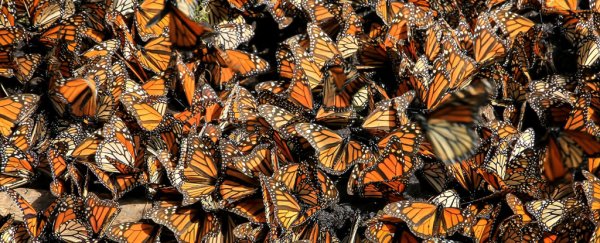Tens of thousands of monarch butterflies are flocking to the California coast for the winter, filling tree branches with fluttering orange wings – a remarkable rebound from years of near-extinction.
Millions of monarchs used to winter in California each year, but their numbers haven't breached half a million since the 1990s. In 2018, the population crashed to new lows: there were fewer than 30,000 monarchs in the state, according to a count that the Xerces Society for Invertebrate Conservation has conducted each winter since 1997.
The butterflies hit a devastating record low last year, numbering fewer than 2,000 across California.
"We were pretty concerned last year that we were potentially facing a reality where there would no longer be monarch butterflies in the Western US," Sarina Jepsen, director of the endangered species program at the Xerces Society, told Insider.
So far this year, however, volunteers have counted more than 100,000 monarch butterflies. That tally is expected to grow as volunteers continue counting through December 5. The Xerces Society will publish its final report in January.
"We're really happy about those numbers," Jepsen said. Still, she added, "this is not yet recovery of the Western monarch population."
A lucky year for monarch butterflies may buy them time
Though this is a hopeful resurgence, scientists don't know what's causing it and aren't sure it will last. Instead of a meaningful recovery, the uptick could be simple luck.
"It is not uncommon at all for any insect population to bounce around from year to year, to have pretty dramatic shifts in the size of its population," Jepsen said.
Still, this year's explosion of butterflies could be a sign that it's not too late to pull monarchs back from the brink of extinction. The butterflies are one of nearly half a million insect species declining in the face of pesticides, habitat destruction, and climate change.
Scientists aren't sure what's making monarch populations so 'bouncy'
Low butterfly populations can be especially "bouncy," fluctuating greatly from year to year, biologists Emma Pelton of the Xerces Society, Elizabeth Crone of Tufts University, and Cheryl Schultz of Washington State University, explained in a blog post for the Xerces Society earlier this month.
Small populations mean individual butterflies aren't competing with each other for resources, the biologists wrote. If it's a good year for plants they eat, like milkweed, there's plenty to eat, and room for the population to boom. And because they can produce three or four generations per year, monarch populations can spike rapidly.
Scientists aren't sure which factors are driving this year's swell. They can only speculate for now.
It could be good weather in the monarch's breeding grounds across Mexico and California. Butterflies benefit from warm, dry summers, followed by cool falls. Or the boom could be linked to changes in the timing and location of California's wildfires, which might affect the butterflies' migration.
A third possibility could be an influx of Eastern monarchs joining the Western migration, although Eastern monarch populations are also declining, occupying 80 percent less forest than they did two decades ago, according to the Center for Biological Diversity.
A brief relief from conditions that hurt monarch migration could also be fueling the swell. Scientists are studying whether pesticide use in California's Central Valley could contribute to monarchs' decline. They're also investigating "resident" monarchs that live in California year round, which some researchers suspect may spread parasites to migrating monarchs.
"With only one year of a population increase, it is impossible to say whether this is the population clawing its way back from the brink, or a blip in the continuation of the migration's decline. We won't know this until we have more years with either more or fewer monarchs," the biologists wrote.
Monarchs have a long climb back from the edge of extinction
While this year's count is promising, it's still only half of what the Western monarch population was five years ago.
The US Fish and Wildlife Service estimates that there's a 99 percent chance that Western monarch populations will reach a point within 60 years where extinction is inevitable. For populations in the East, the probability of extinction inevitability in that time frame is roughly 74 percent.
This year's rebound doesn't necessarily improve those odds.
What would tip the odds in the monarch's favor is restoring their habitats, both in their Mexico breeding grounds and across California, Jepsen said. That involves planting more native wildflowers and milkweed, especially in state parks.
Reducing insecticide use along the butterflies' migration path in the Central Valley could also help, although scientists are still researching the effect the chemicals have on monarchs.
Money for pollinator preservation folded into President Joe Biden's $1 trillion infrastructure bill could help give monarchs a boost. Called the Monarch and Pollinator Highway Act, the legislation creates $10 million in grants for local governments to build pollinator-friendly habitats alongside highways and roads.
"There's a lot of work to do to recover the population," Jepsen said, adding, "But these new numbers give us a bit of hope and a bit of time to implement some of these conservation actions."
This article was originally published by Business Insider.
More from Business Insider:
